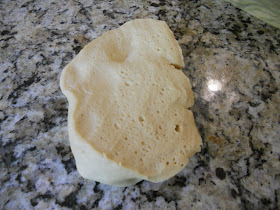Wednesday, September 14, 2011
Give a holla for Challah!
Sunday, September 4, 2011
Pesto bread
 |  |
 |  |
 |  |
 |  |
 |  |
 |  |
 |  |
Tuesday, August 2, 2011
Belgian waffles, the REAL thing.
If you've ever ordered Belgian waffles off an American restaurant menu, you've been misled. I happened across this post when a friend on Facebook posted a link. The author is from Tuscany, and his wife is from Belgium (Liege), and apparently this recipe is from her grandfather's recipes. I don't think it gets more authentic than that.
The waffles are flavorful and sweet - plus a little crunchy. They can be eaten plain or with your favorite toppings, served hot, warm, or cold. They come out pretty small - about 4 inches across. The original recipe said it made 10, so I doubled it, thinking 10 small waffles would not be enough for my family of four. It was enough. It made about 2 dozen waffles, and we have about 16 leftover. They're pretty rich - I ate two and was full.
On to the recipe! (The original can be viewed at www.tuscanfoodie.com)
Waffles from Liege (Adapted for a double recipe)
Batter 1
4 packages active dry yeast
1/2 C lukewarm water
2 C all purpose flour
2T sugar
2 large eggs, beaten
2/3 C lukewarm milk
1. Dissolve the yeast in the water in a bowl, add 1 T flour and 1T sugar. Let it rest for a few minutes until it foams (see picture).
2. Add the remaining flour (you measured by spooning and not scooping,right?) into a large mixing bowl. Make a well in the center.
3. Add the yeast mixture, eggs, and milk. Mix together until smooth. Unlike most American waffle/pancake recipes, this should really be very smooth. (See picture)
4. Cover with plastic wrap and let rise until it has doubled in volume.
Batter 2:
2 sticks + 2 T unsalted butter, room temperature (I told you these were good!)
3 C all purpose flour
1/2 tsp vanilla extract
1/2 tsp baking powder
4 tsp cinnamon
2 oz vanilla sugar (I just used a little more vanilla extract, and used regular sugar)
2 pinches of salt
1 C pearl sugar
* Pearl sugar comes as BB sized pellets of sugar - you can find it at specialty grocery stores (I found it at Central Market) It retains its shape through cooking, and adds a great sweet crunch to the waffles. You can also buy it on Amazon.
1. In your stand mixer, mix all ingredients until well incorporated. It will be like dry cookie dough. (See photo)
2. Add batter 2 to batter 1. If you do it the other way around, it is much more difficult to get all of batter 1 out of the bowl.
3. Mix together with your hands until it forms a well mixed batter. It will be thicker than your usual waffle batter.
Preheat your waffle iron. I've found that the waffles aren't large enough to trigger the sensor in my iron - so I just had to watch it closely. They only take 2-3 minutes to cook.
Drop the batter in about 1/4 cupfuls onto the waffle iron - it's a small enough amount of batter that I was able to make two at once, even on my small round waffle iron.
This makes a lot - set them aside on a rack to cool while you make the rest. Remember, you've got yeast in there (quite a bit, in fact) so if you don't cook them quickly, they will rise and become very dense when you cook them.
What a way to start the day!
Happy... Waffling!
 |  |
 |  |
 |  |
 |  |
 |  |
Saturday, July 2, 2011
Banana Bread. When in doubt, make it twice.
 |  |
 |  |
 |  |
Banana Bread!
I know it's not next on my list, but considering the overripe fruit sitting on my counter, and my plethora of time this long weekend, I thought I would skip to Banana Bread. First, a brief history of time:
The term "pearlash," is used to describe potassium carbonate, which was used to chemically leaven breads in the late 1700s, a process which led to the making of quick breads. Before the discovery of pearlash, breads were leavened mainly by the use of yeast or something containing yeast, such as beer. This was a long process because it takes time for the yeast to grow. With pearlash, quick breads were made possible because the potassium carbonate did the work of the yeast in much less time.
Baking powder was introduced in the mid 1800's, replacing pearlash as a chemical leavening agent allowing the making of quick breads easy for all cooks. Baking powder, or sodium bicarbonate, releases carbon dioxide during the leavening process. A British inventor named Alfred Bird found that by adding a mild acid like cream of tartar to baking soda he could make a stable product that would leaven during the baking process.
Banana bread became popular in the 1930s. Its popularity seems to coincide with the popularity of baking powder by housewives as a leavening ingredient for quick breads.Banana bread is so popular in Australia that February 23rd of every year is set aside as National Banana Bread Day.
Sunday, June 19, 2011
Babka... The Other White Bread.
 |  |
| My favorite co-baker | Mixing the dough |
 |  |
| Ready to Rise | All rolled out! |
 |  |
| Chopped chocolate | Filling is ready |
 |  |
| Filled, rolling it up | All rolled up |
 |  |
| Trust me, it twists! | One more rise to go! |
 |  |
| Ready for the oven | Only minutes from edible! |
 | |
| Amazing. Wonderful. Chocolate. |


















